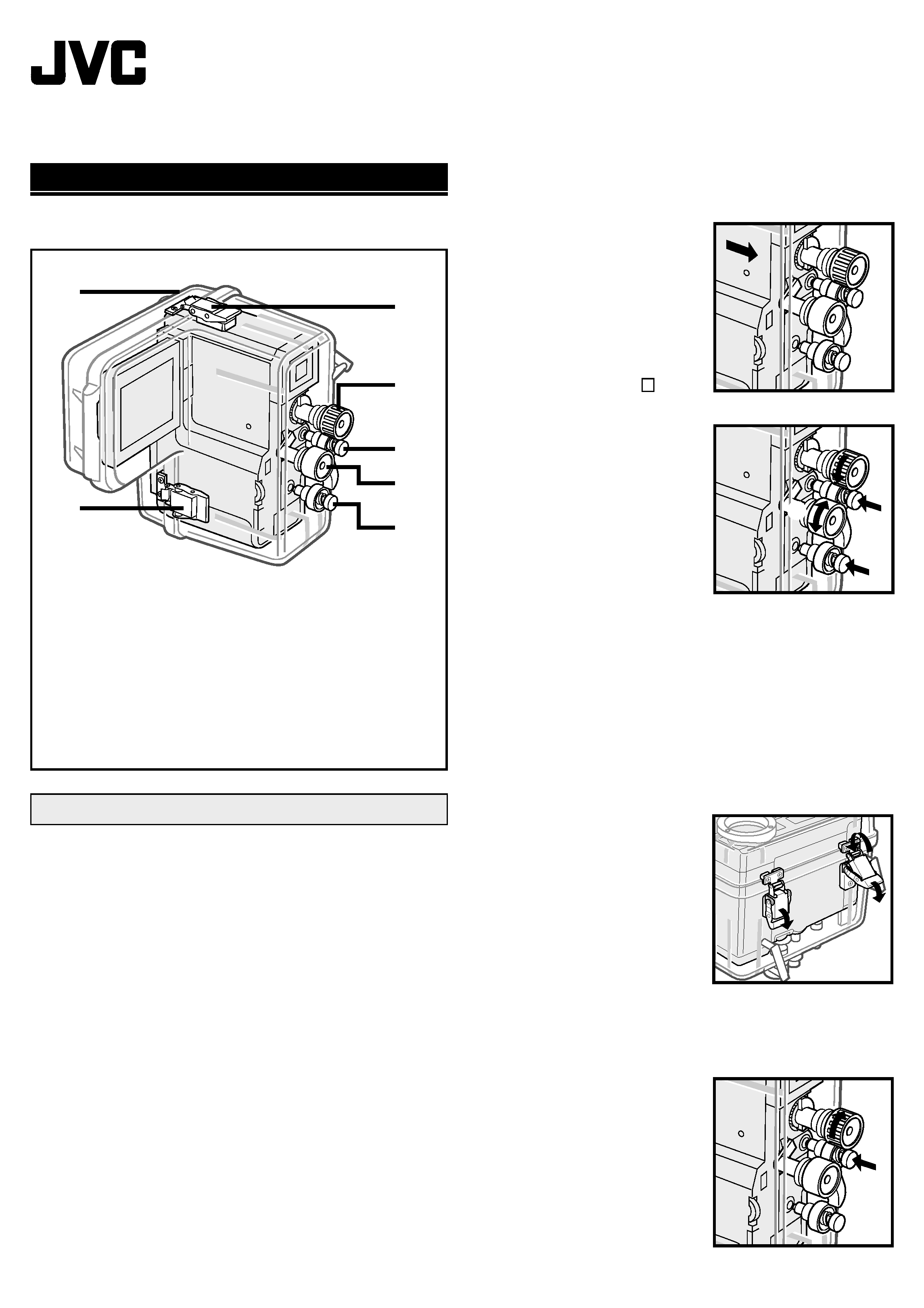
WR-DVXU
Marine Case
User's Manual
ENGLISH
Names of the parts
Please read before use.
This marine case is a precision instrument designed
to permit safe video recording under high water
pressure. Please pay careful attention when handling
the unit before and after use, as explained in this
user's manual.
Each part of the marine case has been subject to
strict controls during the manufacturing process, and
the individual functions have faced stringent tests
during the assembly process. Each marine case has
also had to pass water-proof inspections using high-
pressure water testers. However, damage can some-
times occur during transport and distribution, or
during storage after purchase, so before diving
always carry out the following pre-use test to verify
safety.
Pre-use test
When using the marine case for the first time after pur-
chase, or after it has been in storage for a long time, dive
to the usage depth with only the empty marine case
(without mounting the camcorder inside), and test for
water leaks.
1 ..........Marine case front lid
2 ..........Buckle
3 ..........Power dial
4 ..........START/STOP button
5 ..........Zoom lever
6 ..........SNAPSHOT button
Mounting method and operating method for
each part
1. Remove the four buckles on the marine case and open
the front lid.
2. Remove the camcorder hand strap or grip strap.
3. Open the LCD monitor, then insert the camcorder into
the marine case.
4. Position so that the power
dial projection in the
marine case pushes the
lock button located on the
camcorder power dial.
5. Turn the marine case
power dial to the left to
move the camcorder
power dial to the " A "
position.
6. Place the included anti-
fogging silica gel in the
gap between the
camcorder and the marine
case to prevent fogging in
the marine case.
7. Before sealing the marine
case, check that there is no
sand, dirt, or other foreign
matter on the O-ring
mounted on the front lid or on the O-ring contact
surface on the main unit.
Also make sure that the inserted silica gel bag is not
pinched. If you dive with foreign matter trapped in
these areas, water will leak.
8. Check that the O-ring on the front lid is correctly
mounted in the groove, then press in the front lid.
Flip down the four buckles in the directions indicated
by the arrows in the figure on the right to seal the
marine case.
9. Press the START/STOP
button once to start
recording from the
camcorder (1 in the figure
on the right). Press the
button again to stop
recording (1 in the figure
on the right).
10. The zoom can be adjusted
with the zoom lever (2 in
the figure on the right).
11. It is possible to take a snapshot using the SNAPSHOT
button (3 in the figure on the right).
12. When you are finished
shooting, turn the power
dial to the right to switch
the camcorder power dial
to the Off position (4 in
the figure on the right).
6
5
4
2
3
1
2
4
1
3
2
For GR-DVX
Digital Video Camera
LYT0002-0Q9A

Usage precautions
EN
1. Never use any of the following chemicals for cleaning, rust-proofing, fog prevention, repair, or other purposes.
1) Do not clean the marine case with alcohol, gasoline, paint thinner, or other volatile organic solvents, chemical
cleaners or similar agents. (Pure water or lukewarm water is adequate for cleaning.)
2) Do not use rust-proofing agents or the like on metal parts. (Stainless steel and aluminum are used for all metal
parts, so pure water is adequate for cleaning.)
3) Do not use commercially-available anti-fogging agents. (Always use the fogging agent that came with the marine
case.)
4) Do not use any silicon grease other than that specified for the O-ring. (Always use the silicon grease that came
with the marine case.)
5) Do not use any adhesives for repairs, etc. (If any repairs are necessary, please consult the store of purchase.)
Direct or indirect use (vaporized chemicals) of any of the above chemicals on the marine case can cause cracks
when the marine case is placed under high pressure.
2. Exercise caution, as this marine case is a completely airtight structure. If it is left exposed to direct sunlight, or in a
car, ship, or on the beach, the internal temperature can climb extremely high, which may cause the camcorder inside
to stop working properly.
3. Do not open or close the case in areas where it may be subjected to water spray or sand.
4. If you must open the marine case at the diving site in order to replace the battery or tape, observe the precautions below.
1) Select a location safe from water spray and sand.
2) Use the included blower or similar device to completely blow off water between the main unit and the lid section
of the marine case, and to blow off water adhering to the buckles that fasten them. Dry off any water remaining on
the marine case with a dry cloth.
3) When removing the buckles and opening the lid section, be careful that no water drips from your hair or body into
the marine case.
4) In order to avoid touching the camcorder with hands that have salt water on them, place a towel dampened with
pure water in a plastic bag beforehand and use it to wipe any salt off your hands and fingers before touching the
camcorder.
5. After use, wash off adequately with pure water as soon as possible. If the marine case has been used in salt water,
soaking the marine case in pure water for a while is effective for removing the salt.
6. After washing, wipe off any water with a dry cloth free of salt to completely dry off the marine case. However, do not
expose the marine case to direct sunlight in order to dry it. This can cause discoloration and breakage of the marine
case, and can speed up deterioration of the O-ring.
7. Wipe the inside of the marine case with just a dry cloth. Maintain the transparency of the front glass inside by wiping
it with a silicon cloth or the like before and after use.
8. Remove the O-ring from the lid section and wipe off any salt, sand, and other foreign matter. In the same manner, wipe
off any adhering foreign matter from the groove into which the O-ring was fit and from the main unit of the marine case
where the O-ring contacted it. When removing the O-ring from the groove, avoid using sharp-tipped metal objects;
instead use a round-tipped object, such as a hair pin, to avoid damaging the O-ring when you remove it.
9. When the marine case will be left unused for a prolonged time, to avoid O-ring deformation remove the O-ring from
the marine case groove, apply a thin film of silicon grease, and store it in a clean plastic bag. When setting the O-ring
in place to use the marine case again, carefully check the O-ring for scratches and cracks.
10. Since the marine case is made of acrylic plastic, handle it carefully. In particular, it can be easily scratched by rocks, etc.
at the shooting site and may be damaged if it is dropped or otherwise subject to shock. When going to the shooting site
by car, ship, train, or plane, avoid transporting the camcorder in the marine case. If you take adequate handling precau-
tions, however, there should be no problem in transporting the camcorder in the marine case for a short distance, for
example from the target site to the diving site.
11. Avoid removing any parts other than those indicated in the user's manual, altering the marine case, or using any parts
other than those specified. If any problems occur, please consult the store of purchase.
12. The appearance and specifications of this unit are subject to change without prior notice.
Main specifications
Maximum pressure
: Water depth up to 20 meters
Power switch
: Mechanism can be used
Recording switch
: Mechanism can be used
Main unit dimensions
: 150 (w) x 140 (d) x 160 (h) mm
Main unit weight
: 630 g
Compatible model
: GR-DVX
Accessories
: Maintenance kit (silicon grease, anti-fogging silica gel,blower, paper, lens
cleaning solution, silicon cloth, cotton swabs, carrying case, O-ring)
